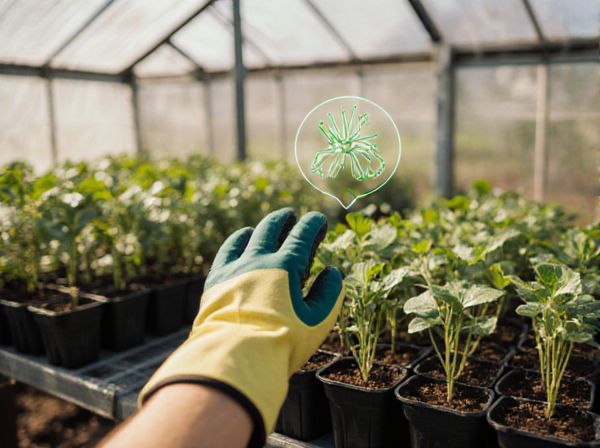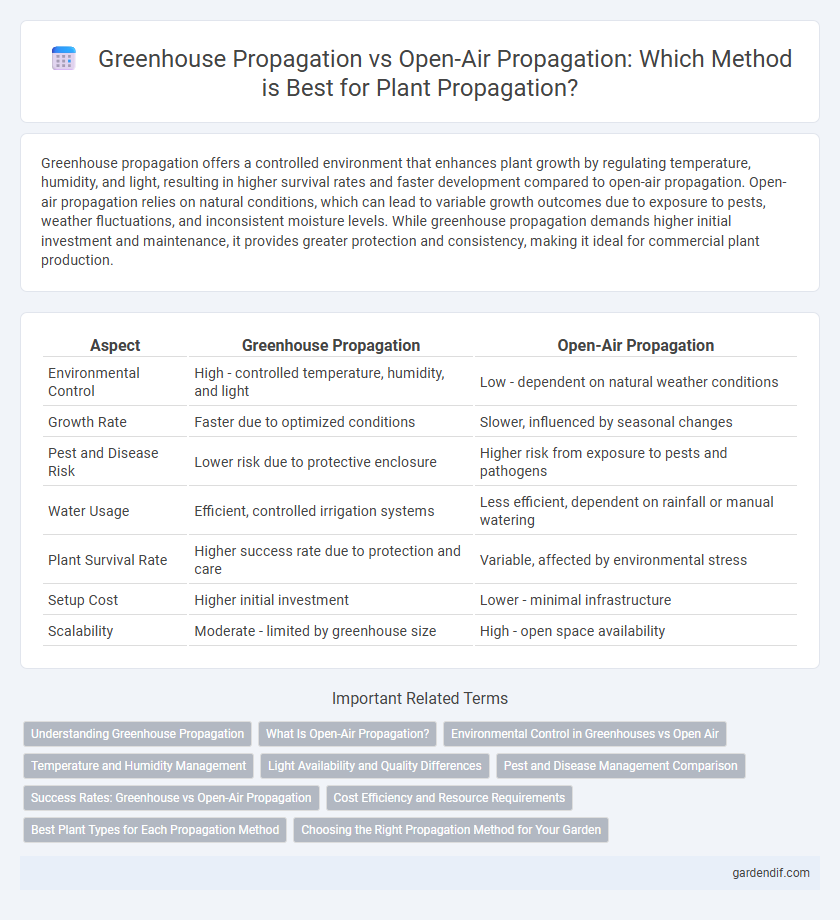
Greenhouse propagation vs open-air propagation Illustration
Greenhouse propagation offers a controlled environment that enhances plant growth by regulating temperature, humidity, and light, resulting in higher survival rates and faster development compared to open-air propagation. Open-air propagation relies on natural conditions, which can lead to variable growth outcomes due to exposure to pests, weather fluctuations, and inconsistent moisture levels. While greenhouse propagation demands higher initial investment and maintenance, it provides greater protection and consistency, making it ideal for commercial plant production.
Table of Comparison
| Aspect | Greenhouse Propagation | Open-Air Propagation |
|---|---|---|
| Environmental Control | High - controlled temperature, humidity, and light | Low - dependent on natural weather conditions |
| Growth Rate | Faster due to optimized conditions | Slower, influenced by seasonal changes |
| Pest and Disease Risk | Lower risk due to protective enclosure | Higher risk from exposure to pests and pathogens |
| Water Usage | Efficient, controlled irrigation systems | Less efficient, dependent on rainfall or manual watering |
| Plant Survival Rate | Higher success rate due to protection and care | Variable, affected by environmental stress |
| Setup Cost | Higher initial investment | Lower - minimal infrastructure |
| Scalability | Moderate - limited by greenhouse size | High - open space availability |
Understanding Greenhouse Propagation
Greenhouse propagation offers controlled environmental conditions that enhance plant growth by regulating temperature, humidity, and light, leading to higher germination rates and faster development compared to open-air propagation. It minimizes exposure to pests and diseases, providing a safer environment for delicate seedlings and cuttings. By optimizing microclimate factors, greenhouse propagation ensures consistent propagation success regardless of external weather variations.
What Is Open-Air Propagation?
Open-air propagation involves growing plants directly in the natural environment without protective structures, relying on ambient conditions such as sunlight, temperature, and humidity. This method allows for natural pollination, airflow, and exposure to pathogens, which can influence plant hardiness and resilience. Compared to greenhouse propagation, open-air propagation requires careful selection of plant species and timing to optimize growth while minimizing risks.
Environmental Control in Greenhouses vs Open Air
Greenhouse propagation offers precise environmental control through regulated temperature, humidity, and light, creating optimal conditions for plant growth year-round. In contrast, open-air propagation relies on natural weather patterns, exposing plants to temperature fluctuations, variable humidity, and uncontrolled light cycles that can stress seedlings. This controlled environment in greenhouses reduces disease risk and enhances propagation success rates compared to the unpredictability of open-air conditions.
Temperature and Humidity Management
Greenhouse propagation offers precise temperature control, maintaining optimal warmth between 70degF and 85degF, which accelerates seed germination and root development. Humidity levels inside a greenhouse can be regulated around 70% to 90%, reducing water stress and promoting uniform growth. In contrast, open-air propagation is subject to fluctuating temperature and humidity, often leading to slower growth and increased risk of plant stress or disease.
Light Availability and Quality Differences
Greenhouse propagation offers controlled light availability with the use of supplemental lighting and diffuse glazing, enhancing photosynthesis by providing consistent light intensity and spectrum. In contrast, open-air propagation relies entirely on natural sunlight, which varies in intensity and quality due to weather conditions and time of day, potentially causing fluctuations in plant growth rates. Light quality in greenhouses can be optimized with specific coatings or LED technology to promote desirable photomorphogenic responses, while open-air methods are limited to the natural solar spectrum.
Pest and Disease Management Comparison
Greenhouse propagation offers a controlled environment that significantly reduces pest infestations and disease outbreaks compared to open-air propagation, where exposure to fluctuating weather conditions increases vulnerability. Integrated pest management in greenhouses benefits from physical barriers, regulated humidity, and temperature controls, limiting pathogen proliferation and insect breeding. Open-air propagation requires more frequent chemical treatments and monitoring due to higher risks of airborne pathogens and pests spreading rapidly.
Success Rates: Greenhouse vs Open-Air Propagation
Greenhouse propagation typically yields higher success rates due to controlled environmental factors such as temperature, humidity, and protection from pests, which optimize plant growth conditions. In contrast, open-air propagation faces variable weather, pest exposure, and inconsistent moisture levels, often resulting in lower germination and survival rates. Studies show greenhouse propagation success can exceed 80%, while open-air methods frequently report success rates below 60%.
Cost Efficiency and Resource Requirements
Greenhouse propagation offers higher cost efficiency by enabling controlled environmental conditions that reduce plant loss and accelerate growth cycles compared to open-air propagation. Resource requirements in greenhouse systems include investments in heating, ventilation, and artificial lighting, which can increase initial costs but lower water and pesticide usage. Open-air propagation has lower setup expenses but often leads to higher resource consumption due to variable weather conditions and greater vulnerability to pests and diseases.
Best Plant Types for Each Propagation Method
Greenhouse propagation is ideal for tropical plants, seedlings, and those requiring controlled humidity and temperature, such as orchids, tomatoes, and peppers, enabling faster growth and protection from pests. Open-air propagation suits hardy, sun-loving plants like herbs, succulents, and native wildflowers, benefiting from natural sunlight, air circulation, and pollination. Selection between propagation methods depends on plant tolerance to environmental factors and desired growth speed.
Choosing the Right Propagation Method for Your Garden
Greenhouse propagation offers a controlled environment with consistent temperature, humidity, and protection from pests, which enhances seed germination and young plant growth. Open-air propagation relies on natural conditions, providing less control but reducing energy costs and encouraging hardier plant development due to environmental exposure. Selecting the appropriate propagation method hinges on your garden's climate, available resources, and the specific plant species' sensitivity and growth requirements.
Greenhouse propagation vs open-air propagation Infographic

 gardendif.com
gardendif.com